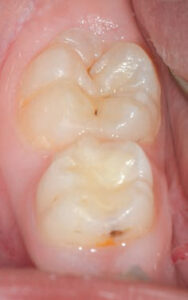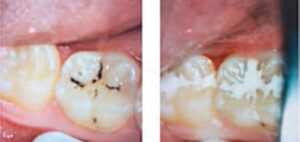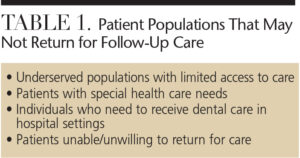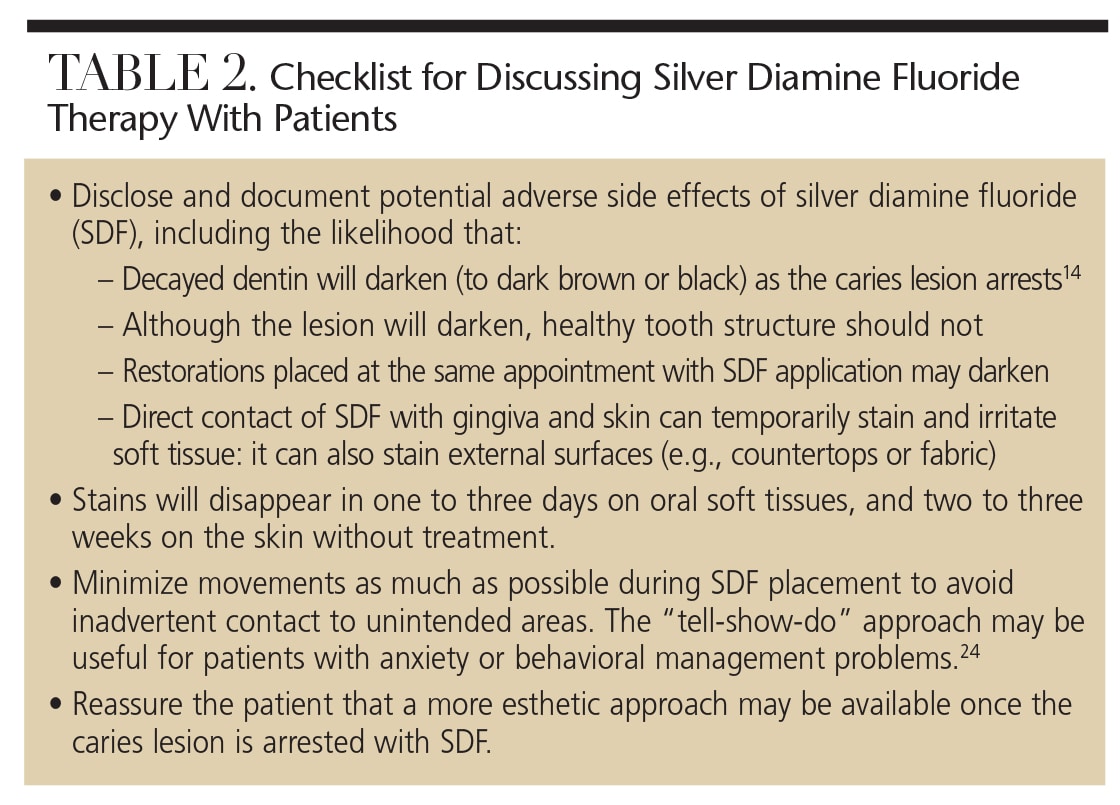
Caries Arrest With Silver Diamine Fluoride
The use of this agent offers many benefits in managing lesions, especially among underserved and low-income populations.
PURCHASE COURSE
This course was published in the October 2016 issue and expires 10/31/19. The author has no commercial conflicts of interest to disclose. This 2 credit hour self-study activity is electronically mediated.
OBJECTIVES
After reading this course, the participant should be able to:
- Describe silver diamine fluoride’s (SDF) mechanism of action.
- Identify possible uses for SDF in clinical practice.
- List the contraindications for SDF.
- Discuss the technique for using SDF.
In light of the fact that dental caries remains a significant problem across all age groups,1 researchers have long sought additional approaches to caries management.2 Among these, caries management by risk assessment (CAMBRA) is based on the unique risks faced by each patient.3 The CAMBRA protocol is an evidence-based approach to preventive and reparative treatment of early caries lesions that can be integrated into any dental setting. Sample CAMBRA protocols have been published and updated for children4 and adults.5,6 These guidelines focus on modifying individuals’ risk factors via a combination of chemotherapeutic interventions, coupled with behavioral modifications targeted at altering microbiota while supporting tooth remineralization.
Although silver diamine fluoride (SDF) has long been used in Japan, Australia and Argentina for caries prevention, and the value of silver ions to treat dental caries has been known for more than a century, SDF only recently became available in the United States. In 2014, the U.S. Food and Drug Administration cleared SDF for marketing as a Class II medical device for treating dentinal hypersensitivity in adults. Consequently, choosing this chemotherapeutic option for caries management in the U.S. is considered off-label use, similar to fluoride varnish. As with other forms of off-label use, clinicians should use professional judgment when applying SDF for caries management.7
A 2009 systematic review reported that SDF is a safe and effective caries-preventive agent that appears to meet both the World Health Organization’s Millennium Goals and the U.S. Institute of Medicine’s criteria.8 The use of SDF to chemically arrest active caries eliminates the need for local anesthesia and electric or air-turbine handpieces, which can improve children’s experience in the dental office. This paper will review the scientific properties of SDF and its clinical applications for caries arrest.
MECHANISM OF ACTION
An inexpensive and colorless topical agent, SDF offers clinicians another option for preventing and treating caries.9 Silver is a substantive antimicrobial that limits the reinvasion of cariogenic bacteria after application.10 The fluoride ions promote remineralization. Upon application of SDF to a decayed surface, a silver-protein conjugate layer forms, which increases resistance to acid dissolution and enzymatic digestion.11 Treated lesions will increase in mineral density and hardness as lesion depth decreases.12
Recently, Horst et al9 recommended the widespread off-label use of SDF for preventing and treating caries in the U.S. In January 2016, the Current Dental Terminology (CDT) billing code 1354 for interim caries arresting medicament application became active. It states: “Conservative treatment of an active, nonsymptomatic caries lesion by topical application of a caries-arresting or inhibiting medicament without mechanical removal of sound tooth structure.” With the introduction of CDT 1354, Medicaid began reimbursing for the application of SDF.
Several randomized clinical trials evaluated the efficacy of SDF in treating dental caries. Two studies in children demonstrated 91% to 93% caries arrest after two years to three years of biannual application.13,14 And with annual application, two studies showed 65% to 79% arrest after two years to two-and-a-half years.15,16 A dose-response relationship was seen, with better outcomes associated with more frequent application.14 Reapplication appears to provide additional benefits; after 12 months, the caries arrest rate plummeted without reapplication,16 but it increased with reapplication.14 Thus, oral health professionals may wish to observe the effects of SDF before prematurely prescribing conventional restorative dentistry. Studies have reported better caries prevention with annual application of SDF, compared with other topical medicament treatments, such as four-times-per-year applications of fluoride varnish15,17 or chlorhexidine varnish.17
Two reports using silver compounds (SDF or silver nitrate plus fluoride varnish) have shown the potential to dramatically reduce the need to treat children with behavior issues for early childhood caries in hospital settings. The first report was from a private practice setting in which Medicaid-eligible children represented a large percentage of the patient population.18 The second was from a large Medicaid-managed care organization in Oregon with hundreds of thousands of enrollees.19
As a dental agent, SDF has an impressive safety profile. Based on a large, 500-fold LD-50 (lethal-dose for 50% of those who imbibe a particular dose) safety margin and a postulated 100% absorption, a single drop (25 ul) results in a reasonable dose limit of 1 drop/10 kg (~22 lbs) child per visit.9 Predictable side effects include blackening of the treated lesion, a short-lived bitter metallic taste, and temporary staining of soft tissues. This agent also has been shown to stain clinical surfaces and leave residual stains on treatment trays. As a result, reasonable caution is advised to avoid touching patients’ soft tissues, as well as clinical surfaces. In addition, patients should be told to expect the lesion to darken substantially over a week’s time.
USE IN CLINICAL PRACTICE
Before placing SDF, oral health professionals should consider whether a patient is appropriate for this treatment. As previously mentioned, SDF is used off label for arresting caries, especially among select populations. It will likely benefit patients diagnosed with salivary dysfunction, individuals with special health care needs, the underserved, medically compromised individuals, and patients with severe early childhood caries. It may also be useful for treating lesions that would otherwise be difficult or impossible to treat with traditional methods.9 Furthermore, SDF is likely useful when applied to enamel pit and fissure surfaces of patients at high caries risk who may not be able to tolerate conventional sealants. In addition, SDF can be used in conjunction with sealants when a lesion is suspected, but has not been visualized.
Once it is determined that a patient is a candidate for SDF treatment, oral health professionals must receive informed consent from patients or parents/caregivers regarding the risks, benefits and alternatives to SDF therapy.
Clinicians should also consider if repeated SDF application is appropriate. For example, when treating a patient who is not likely to return for follow-up evaluation and treatment (Table 1), clinicians should consider the following options:
- Not placing SDF
- Placing SDF only once, with the understanding the patient may not return for subsequent applications
- Placing SDF and a glass ionomer cement (GIC) sealant/restoration at the same appointment
CONTRAINDICATIONS
While SDF is safe, clinicians should exercise caution in some situations. For a tooth that is symptomatic, partially necrotic or otherwise pulpally involved, SDF may not be beneficial, and immediate traditional treatment may be a better approach. With careful application, SDF will not go beyond treated sites, but patients and providers should be aware that SDF will cause stinging if it contacts soft tissue ulcerations or lacerations.
Patients who refuse the use of fluoride may require extended discussions to obtain informed consent. Clinicians may wish to mention that SDF is twice as concentrated as fluoride varnish, but less than half the volume is used, lowering the total fluoride dose.
A meta-analysis of long-term clinical trials reported that heavy body (i.e., low viscosity) GICs are at least as effective as resin sealants in preventing caries in permanent molars.20 With conventional GICs, maximal remineralization occurs at the tooth interface.21
It is worth noting that light curing is not needed when using conventional GIC restorative materials, which is clinically relevant because light curing after SDF placement can increase the darkening of the lesion. In situations in which patient behavior necessitates short treatment times, a resin modified glass ionomer may be more appropriate than other light-cured restoratives, due to their shorter curing times. Light curing oxidizes SDF, which precipitates the silver out of the solution and turns plastic-based fillings dark immediately. This occurs for light cured resin-modified glass ionomers just as with composite. The silver on healthy enamel can be polished off.
REGULATORY CONSIDERATIONS
Providers are encouraged to examine their states’ dental board regulations to determine who can lawfully place SDF, sealants and nonsurgical restorations. Clinicians who are permitted to place fluoride varnish will most likely be able to place SDF. In some states, however, it is unclear who, other than dentists, are credentialed to perform caries arrest by medicament (CDT 1354). Where nondentists are permitted to perform caries arrest procedures, these should be performed in collaboration with the dentist of record and/or as dictated by state laws.
ENSURING PATIENT COMMUNICATION

After completing a thorough exam, charting, and caries risk assessment, treatment plan options should be discussed with the patient.5 With guidance from an appropriate oral health professional, patients should ultimately choose the best SDF option, as determined by their wants, needs, financial status, and abilities to cooperate with proposed treatment. Appropriate discussions with a patient or parent/caregiver can motivate and encourage treatment aimed at preventing or halting disease progression, thereby eliminating or limiting the need for more invasive procedures in the future. Table 2 provides a checklist for use when discussing SDF therapy with patients.
TECHNIQUE

FIGURE 2 COURTESY STEVE DUFFIN, DDS
Arresting a caries lesion with SDF may be beneficial when traditional methods are not likely to succeed. In the case of a patient with multiple lesions that cannot be immediately restored, SDF can slow the disease process and decrease sensitivity until definitive restorative care can be performed. Repeated application of SDF may help preserve tooth structure. In such cases, reapplication has been recommended at least biannually until a tooth exfoliates, is extracted, or the tooth is restored.9 In situations in which restorations are not an option, repeated applications of SDF may be the best option (Figure 1).
The mechanics of how practitioners are coding and billing for SDF application with restoration are still evolving. Clinical applications in which SDF is combined with GIC sealant/restoration include:
1. Multiple applications of SDF, followed by GIC sealant/restoration after lesion arrest (Figure 2)
Ideally, the preferred approach relies on multiple applications of SDF, followed by placement of a restoration (if needed);9 however, there may be situations in which a practitioner will only be able to see the patient once (Table 1).

FIGURE 3 COURTESY CINDY Y. LEE, DMD
2. Single application of SDF, with immediate GIC sealant/restoration (Figure 3)
If there is concern that a patient may not return for multiple SDF applications, or if a patient has large numbers of active lesions or particularly large lesions (making it impractical to restore all teeth at one appointment), less time-consuming techniques — such as SDF in combination with immediate GIC sealant/restoration placement — may be considered.22
3. Arrest and repair secondary caries with SDF
At an existing restorative margin, SDF can be applied to arrest secondary caries, followed by repair of the restoration (if appropriate and consistent with tooth preservation strategies).23 Placement of SDF and GIC sealant/restoration is considered a restorative CDT code. It is not appropriate to bill CDT 1354 along with immediate placement of GIC sealant/restoration.
CONCLUSION
The science and versatility of SDF make a strong case for its widespread adoption for caries management. Applying SDF does not preclude the option of subsequent placement of traditional restorations for the purposes of esthetics, comfort and function. This agent offers disinfection and remineralization properties that can reduce the need for traditional invasive procedures. Combining the synergistic compatibilities of SDF and conventional GIC offers new ways to empower and motivate dental professionals and patients to transform disease to health.
Acknowledgment: Jeremy A. Horst, DDS, MS, PhD, was supported by National Institutes of Health/National Institute of Dental and Craniofacial Research Grant T32-De007306.
References
- Beltran-Aguilar E, Barker L, Canto M, et al. Surveillance for dental caries, dental sealants, tooth retention, edentulism, and enamel fluorosis — United States, 1988–1994 and 1999–2002. MMWR Surveill Summ. 2005;26:1–43.
- Young DA, Novy BB, Zeller GG, et al. The American Dental Association caries classification system for clinical practice: A report of the American Dental Association Council on Scientific Affairs. J Am Dent Assoc. 2015;146:79–86.
- Featherstone JD. The caries balance: the basis for caries management by risk assessment. Oral Health Prev Dent. 2004;1(2 Suppl):259–264.
- Ramos-Gomez F, Ng MW. Into the future: keeping healthy teeth caries free: pediatric CAMBRA protocols. J Calif Dent Assoc. 2011;39:723–733.
- Hurlbutt M, Young DA. A best practices approach to caries management. J Evid Based Dent Pract. 2014;14(Suppl):77–86.
- Jenson L, Budenz AW, Featherstone JD, Ramos-Gomez FJ, Spolsky VW, Young DA. Clinical protocols for caries management by risk assessment. J Calif Dent Assoc. 2007;35:714–723.
- Featherstone JD, Horst JA. Fresh approach to caries arrest in adults. Decisions in Dentistry. 2015;1(1):36–44.
- Rosenblatt A, Stamford TC, Niederman R. Silver diamine fluoride: a caries “silver-fluoride bullet.” J Dent Res. 2009;88:116–125.
- Horst JA, Ellenikiotis H, Milgrom PM. UCSF protocol for caries arrest using silver diamine fluoride: rationale, indications, and consent. J Calif Dent Assoc. 2016;44:16–28.
- Knight GM, McIntyre JM, Craig GG, Mulyani, Zilm PS, Gully NJ. Inability to form a biofilm of Streptococcus mutans on silver fluoride- and potassium iodide-treated demineralized dentin. Quintessence Int. 2009;40:155–161.
- Mei ML, Li QL, Chu CH, Yiu CK, Lo EC. The inhibitory effects of silver diamine fluoride at different concentrations on matrix metalloproteinases. Dent Mater. 2012;28:903–908.
- Mei ML, Ito L, Cao Y, Li QL, Lo EC, Chu CH. Inhibitory effect of silver diamine fluoride on dentine demineralisation and collagen degradation. J Dent. 2013;41:809–817.
- Llodra JC, Rodriguez A, Ferrer B, Menardia V, Ramos T, Morato M. Efficacy of silver diamine fluoride for caries reduction in primary teeth and first permanent molars of schoolchildren: 36-month clinical trial. J Dent Res. 2005;84:721–724.
- Zhi QH, Lo EC, Lin HC. Randomized clinical trial on effectiveness of silver diamine fluoride and glass ionomer in arresting dentine caries in preschool children. J Dent. 2012;40:962–967.
- Chu CH, Lo EC, Lin HC. Effectiveness of silver diamine fluoride and sodium fluoride varnish in arresting dentin caries in Chinese preschool children. J Dent Res. 2002;81:767–770.
- Yee R, Holmgren C, Mulder J, Lama D, Walker D, van Palenstein Helderman W. Efficacy of silver diamine fluoride for arresting caries treatment. J Dent Res. 2009;88:644–647.
- Tan HP, Lo EC, Dyson JE, Luo Y, Corbet EF. A randomized trial on root caries prevention in elders. J Dent Res. 2010;89:1086–1090.
- Duffin S. Back to the future: the medical management of caries introduction. J Calif Dent Assoc. 2012;40:852–858.
- Shirtcliff M. Testimony given to the Oregon state legislature. Available at: https://olis.leg.state.or.us/liz/2013R1/Downloads/CommitteeMeetingDocument/7702. Accessed September 12, 2016.
- Mickenautsch S, Yengopal V. Caries-preventive effect of high-viscosity glass ionomer and resin-based fissure sealants on permanent teeth: a systematic review of clinical trials. PLoS One. 2016;11:e0146512.
- Ngo H, Ruben J, Arends J, et al. Electron probe microanalysis and transverse microradiography studies of artificial lesions in enamel and dentin: a comparative study. Adv Dent Res. 1997;11:426–432.
- Frachella JC. Stainless steel crowns. J Am Dent Assoc. 2015;146:495–496.
- Tyas MJ, Anusavice KJ, Frencken JE, Mount GJ. Minimal intervention dentistry — a review. FDI Commission project 1–97. Int Dent J. 2000;50:1–12.
- Strom K, Ronneberg A, Skaare AB, Espelid I, Willumsen T. Dentists’ use of behavioural management techniques and their attitudes towards treating paediatric patients with dental anxiety. Eur Arch Paediatr Dent. 2015;16:349–355.
From Decisions in Dentistry. October 2016;2(10):48–51.







“What’s new is old…” Isn’t this like the old silver amalgam fillings? They would get darker with time. And why couldn’t they keep using them but without the mercury content?